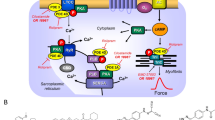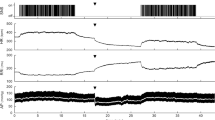Summary
The aim of the present investigation was to study the effects of a single 100-µg i.v. administration of the synthetic heptadecapeptide [β-Ala1-Lys17]ACTH1–17-4-amino-N-butylamide (ACTH 1–17) on the left ventricular performance. The systolic time intervals (STI) were recorded in 20 healthy adult young subjects (10 treated with ACTH 1–17 and 10 receiving placebo) before as well as 20, 40, 60 and 80 min after the i.v. ACTH 1–17 or placebo infusion. The STI were recorded immediately after blood withdrawal for measuring cortisol, aldosterone, adrenaline and noradrenaline plasma levels. A highly significant statistical difference was demonstrated for preejection period (PEP) and preejection period/left ventricular ejection time (PEP/LVET) ratio between subjects treated with ACTH 1–17 and subjects receiving placebo. As expected, a significant increase of cortisol and aldosterone plasma levels was observed in subjects treated with ACTH 1–17. The difference of adrenaline and noradrenaline plasma levels was statistically highly significant between subjects treated with ACTH 1–17 and those receiving placebo. The lack of increase in PEP and PEP/LVET ratio recorded in subjects treated with ACTH 1–17 is consistent with an increased left ventricular contractile performance. An increased plasma catecholamine release is postulated as the mechanism of this improvement.
Similar content being viewed by others
References
Axelrod J.: ACTH and related peptides: structure, regulation and action — Ann. N.Y. Acad. Sci.297, 275, 1977.
Cousineau D., Lapointe L., Champlain J.: Circulating catecholamines and systolic time intervals in normotensive and hypertensive patients with and without left ventricular hypertrophy — Amer. Heart J.96, 227, 1978.
Da Prada M., Zürcher G.: Simultaneous radioenzymatic determination of plasma and tissue adrenaline, noradrenaline and dopamine within the fentomole range — Life Sci.19, 1161, 1976.
Fenske M., Fuchs E., Probst B.: Corticosteroid, catecholamine and glucose plasma levels in rabbits after repeated exposure to a novel environment or administration of ACTH 1–24 or insulin — Life Sci.31, 127, 1982.
Garrard J. A. Jr.,Weissler A. M., Doge H. T.: The relationship of alterations in systolic time intervals to ejection fraction in patients with cardiac disease — Circulation42, 455, 1970.
Geiger R.: Synthese eines Heptadecapeptids mit hoher adrenocorticotroper Wirkung — Liebig’s Ann. Chem.750, 165, 1971.
Gerwitz G. P., Kvetnansky R., Weise V. K., Kopin I.: Effects of hypophysectomy on adrenal dopamine-β-hydroxylase activity in the rat — Molec. Pharmacol.7, 163, 1971.
Harris W. S., Schoenfeld C. D., Weissler A. M.: Effects of adrenergic receptor activation and blockade on the systolic preejection period, heart rate and arterial pressure in man — J. clin. Invest.46, 1704, 1967.
Levi G. F., Quadri A., Ratti S., Basagni M.: Preclinical abnormality of left ventricular function in chronic alcoholics — Brit. Heart J.39, 35, 1977.
Levi G. F., Ratti S., Cardone G., Basagni M.: On the reliability of systolic time intervals — Cardiology69, 157, 1982.
Lindner E., Schölkens B.: ACTH and α-MSH: cardiovascular and antiarrhythmic properties — Arch. int. Pharmacodyn.280, 19, 1974.
Martin C. E., Shaver J. A., Thompson M. E., Reddy P. S., Leonard J. J.: Direct correlation of external systolic time intervals with internal indices of left ventricular function in man — Circulation44, 419, 1971.
Müller R. A., Thoenen H., Axelrod J.: Effects of pituitary hormones and ACTH on the maintenance of the basal tyrosine hydroxylase activity in the rat adrenal gland — Endocrinology86, 751, 1970.
Reinberg A., Brière L., Fraboulet G., Guillemant J., Dupont W., Guillet P., Nicolai A.: Clinical chronopharmacology of ACTH 1–17. III. Effects on fatigue, oral temperature, heart rate, grip strength and bronchial patency — Chronobiologia8, 101, 1981.
Sandow J., Geiger R., Vogel H. G.: Pharmacological effects of a short chain ACTH analogue — Naunyn-Schmiedeberg’s Arch. exp. Pathol. Pharmakol.297, 65, 1977.
Schechter E., Wilson M. F., Kong Y. S.: Physiological responses to epinephrine infusion: the basis for a new stress test for coronary artery disease — Amer. Heart J.105, 554, 1983.
Weinshilboum R., Axelrod J.: Dopamine-β-hydroxylase activity in the rat after hypophysectomy — Endocrinology87, 894, 1970.
Weissler A. M., Harris W. S., Schoenfeld C. D.: Systolic time intervals in heart failure in man — Circulation37 149, 1968.
Author information
Authors and Affiliations
Rights and permissions
About this article
Cite this article
Levi, G., Signorini, C., Tosoni, S. et al. Positive inotropic effects of an acth analogue (ACTH 1–17) on myocardial performance. La Ricerca in Clin. Lab. 15, 349–356 (1985). https://doi.org/10.1007/BF03029150
Accepted:
Issue Date:
DOI: https://doi.org/10.1007/BF03029150




